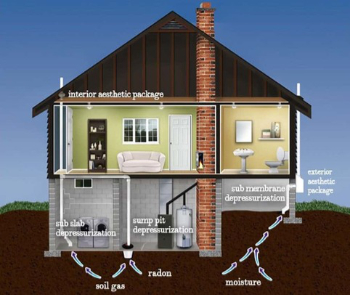What system is best for my home?
Radon depressurization systems come in many types based on the construction of your home.
Below is a list of the 4 most common systems we use. Which system is best for you? Let's find out:
Sub-Slab depressurization:
Sub-Slab systems utilize the existing concrete slab in your basement to effectively pull radon from underneath your home and exhaust it safely outside. This is achieved by drilling a 5-inch suction hole through the slab, a pit is dug underneath and a suction pipe is inserted. The radon fan, once turned on creates suction and begins to draw radon that would have gotten into your home and expels it outside where it safely disperses into the atmosphere. Along with other necessary mitigation applications such as crack filling, sump lid sealing, backer rod installation and so on, this system is very efficient and will work well for years to come.

Drain-tile depressurization:
This is an active soil-depressurization system whereby a suction point is located within the drain tile. Generally, Drain-Tile depressurization systems are installed during a new homes construction. A contractor can connect the vent pipe to the drain tile and run the vent pipe inside interior walls up to the attic where a Radon Specialist will make the final tie in with the proper radon exhaust fan.
In this particular application the radon fan assembly is located inside the attic and exhausts out the roof of the home. This type of system can be very cost effective when done during the homes construction but very cost prohibitive if done after the home is finished. The benefit of this system is that the entire radon system is hidden from view.
Sub-membrane depressurization:
This is an active radon mitigation system that creates negative air pressure under a vapor barrier to draw radon out and away from the home. These systems work by sealing off the existing dirt/gravel floor and drawing radon from underneath. It's crucial to a system like this that the plastic membrane not be disturbed after the install is complete due to risks of tears, punctures and other damage that could prevent the system from working as efficiently as designed.
Sump pit depressurization system:
is a radon mitigation system that has a suction point installed in the sump lid. This type of system utilizes the existing drain pipes that run underneath your concrete slab to help carry water to your sump. We can utilize this network of pipes to draw radon out from underneath your slab in the same way water is drawn out. Using an existing sump as our suction point allows our systems to have a smaller footprint, a cleaner install and a less noticeable mitigation system in your home.
